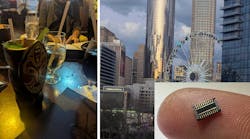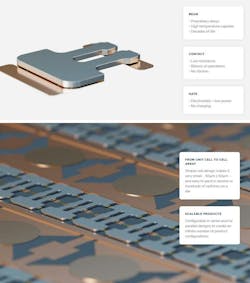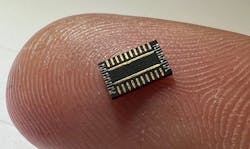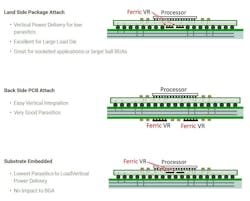Tales of Tech and Tiki: Old Friends Debate APEC 2025’s Most Disruptive Technologies
What you’ll learn:
- Menlo Microsystems’s MEMS-based switch arrays support exceptionally high power densities and high reliability for both power and RF applications.
- Ferric’s unique ability to integrate high-quality monolithic inductors into the packaging of semiconductor devices changes what’s possible in many power-conversion applications.
- Both companies’ potentially disruptive advantages arise from “out-of-left-field” technologies that are the product of decades’ worth of basic research.
Greetings from Atlanta, Ga., a city of many contrasts, where the Martin Luther King Jr. Historical Park and the World of Coca Cola Museum peacefully cohabitate along the edges of the city’s magnificent Centennial Olympic Park, which was also the site of the IEEE’s APEC 2025 power tech conference (Fig. 1). It was a real pleasure to team up with my esteemed colleagues (Alix Paultre and James Morra) to cover the huge array of innovative products and technologies emerging from the four-day event.
During a rare break in the action, Alix and I met up over exotic cocktails at the infamous Trader Vic’s tiki lounge to get some perspective on the APEC experience (Figs. 2 and 3). As the calming alcoholic haze set in, we agreed that the bulk of what we’d seen consisted of important, but predictable, evolutionary developments in existing product categories.
We also noted that we’d had the pleasure of stumbling on a small handful of truly unique, and potentially disruptive, developments. Two of my most interesting and unexpected finds were from Ferric and Menlo Microsystems, two relatively small companies whose technologies that may make an outsized impact on the future of power design.
>>Check out more of our APEC 2025 coverage
A Tiny Switch May Trigger Big Changes
Menlo Microsystems’s deceptively simple-looking MEMS-based switch structures offer a number of advantages over today’s semiconductor-based and conventional mechanical switching solutions. Menlo’s “Ideal Switch” structures are fabricated in large arrays by depositing an electrostatically activated beam on a glass substrate using a (mostly) standard MEMS process (Fig. 4, top). The resulting device has low-resistance, corrosion-resistant contact surfaces.
This process can be used to fabricate rugged arrays of switches with remarkably high current densities and low parasitic effects. It enables them to support high-power switching applications from DC to tens of GHz (Fig. 4, bottom).
In addition to their longevity and ability to support switching speeds on the order of microseconds, these unique switches display several other surprising properties. Perhaps the most significant (and counterintuitive) aspect of the switch is that the microscopic gap between their open contacts is so small that it doesn’t support the conditions necessary to handle arcing due to ionization-related phenomena encountered by conventional switches.
Chris Umminger, Sr. Director for Power Design at Menlo Micro, explained that due to Paschen’s law, breakdown voltage increases at very small gaps and low gas pressures because the gap becomes too small for the mean free path of ions to sustain an avalanche ionization.
Menlo Micro’s technology was made possible by a decade or more of research into several unique fabrication technologies. To effectively connect their robust micro-relays, they developed a process that makes it possible to precisely form microscopic holes through the glass substrate, which can be turned into highly-conductive plated-through vias (Fig. 5).
Developed in conjunction with an R&D division of Corning Glass, the low-resistance, low-parasitic vias are one of the key breakthroughs that make it possible to use the same technology to build extremely compact, high-power switching devices for power switching, power management, and RF applications (see the video below). You can download a whitepaper that provides a closer look at the technology behind Menlo Micro’s MEMS power switches.
Micro-Inductors Lead to Powerful Innovation
Ferric, another example of a relatively small company I discovered at APEC, stands a decent chance of disrupting an established industry segment with an out-of-left-field technology. It enables the fabrication of high-quality monolithic power inductors within the device’s package to create chip-scale modules that eliminate both the real estate and parasitics associated with external components (Fig. 6).
The first application Ferric targeted is advanced voltage regulators to address the unique needs of today’s ultra-high-powered AI processors and advanced server CPUs.
While at least a dozen companies offered excellent solutions to deliver the near-impossible currents required to power modern GPUs, Feric developed a unique capability to integrate thin-film magnetic power inductors within their devices’ packages that eliminates the need for bulky external components. As a result, they can create chip-scale power converters that integrate interface, telemetry, feedback control, and powertrain circuitry (including power FETs, inductors, and capacitors).
Ferric claims that these devices, which they refer to as integrated voltage regulators (IVRs), can be up to 25X smaller, >100X faster, and >30% more efficient than other commonly used converter solutions. For example, the Fe17XX IVR series, which is housed in a 20-mm2 package, is able to deliver 56 A at output voltages ranging from 0.25 to 1.5 V.
In addition to their high efficiency, Ferric’s IVRs reduce the amount of PCB real estate required to implement the “Land Side Package Attach” and “Back Side PCB Attach” vertical power -elivery architectures presently in use. Both configurations allow for the converters to be with fed relatively higher voltages and lower currents, minimizing the distance that their low-voltage/high-current outputs need travel to reach the GPU chip.
In addition, thanks to their compact form factor, the IVRs can be used in a “Substrate Embedded” configuration. They’re located within the substrate of the GPU’s carrier PCB, where the high-current power feed is reduced to a small handful of millimeters (Fig. 7).
Beyond working with processor manufacturers and system integrators to incorporate its converters in their products, Ferric is also licensing the monolithic inductor technology to TSMC for use in other highly integrated monolithic CMOS products and in 3D chip stacks. Information about Feric’s initial IVR products and development boards is available here.









